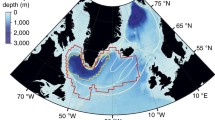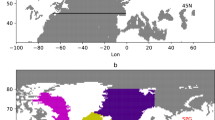Abstract
Global mean surface air temperature has increased over the past century and climate models project this trend to continue. However, the pattern of change is not homogeneous. Of particular interest is the subpolar North Atlantic, which has cooled in recent years and is projected to continue to warm less rapidly than the global mean. This is often termed the North Atlantic warming hole (WH). In climate model projections, the development of the WH is concomitant with a weakening of the Atlantic meridional overturning circulation (AMOC). Here, we further investigate the possible link between the AMOC and WH and the competing drivers of vertical mixing and surface heat fluxes. Across a large ensemble of 41 climate models we find that the spatial structure of the WH varies considerably from model to model but is generally upstream of the simulated deep water formation regions. A heat budget analysis suggests the formation of the WH is related to changes in ocean heat transport. Although the models display a plethora of AMOC mean states, they generally predict a weakening and shallowing of the AMOC also consistent with the evolving depth structure of the WH. A lagged regression analysis during the WH onset phase suggests that reductions in wintertime mixing lead a weakening of the AMOC by 5 years in turn leading initiation of the WH by 5 years. Inter-model differences in the evolution and structure of the WH are likely to lead to somewhat different projected climate impacts in nearby Europe and North America.










Similar content being viewed by others
References
Ba J, Keenlyside NS, Latif M, Park W, Ding H, Lohmann K, Mignot J, Menary M, Otterå OH, Wouters B et al (2014) A multi-model comparison of Atlantic multidecadal variability. Clim Dyn 43(9–10):2333–2348
Booth B, Dunstone N, Halloran P, Bellouin N, Andrews T (2012) Aerosols indicated as prime driver of 20th century North Atlantic climate variability. Nature 484(7393):228–232. doi:10.1038/nature10946
Collins M, Knutti R, Arblaster J, Dufresne J, Fichefet T, Friedlingstein P, Gao X, Gutowski W, Johns T, Krinner G, Shongwe M, Tebaldi C, Weaver A, Wehner M (2013) Chapter 12: Long-term climate change: Projections, commitments and irreversibility. In: Climate Change 2013: The Physical Science Basis Contribution of Working Group I to the Fifth Assessment Report of the Intergovernmental Panel on Climate Change
DelSole T, Tippett MK, Shukla J (2011) A significant component of unforced multidecadal variability in the recent acceleration of global warming. J Clim 24(3):909–926
Delworth T, Mann M (2000) Observed and simulated multidecadal variability in the Northern Hemisphere. Clim Dyn 16(9):661–676
Drijfhout S, Van Oldenborgh GJ, Cimatoribus A (2012) Is a decline of amoc causing the warming hole above the north atlantic in observed and modeled warming patterns? J Clim 25(24):8373–8379
Dunstone N, Smith D, Eade R (2011) Multi-year predictability of the tropical Atlantic atmosphere driven by the high latitude North Atlantic ocean. Geophysical Research Letters 38(14)
Flato G, Marotzke J, Abidun B, Braconnot P, Chou S, Collins W, Cox P, Driouech F, Emori S, Eyring V, Forest C, Gleckler E, Guilyardi E, Jakob C, Kattsov V, Reason C, Rummukainen M (2013) Chapter 9: Evaluation of Climate Models. In: Climate Change 2013: The Physical Science Basis Contribution of Working Group I to the Fifth Assessment Report of the Intergovernmental Panel on Climate Change
Folland C, Palmer T, Parker D (1986) Sahel rainfall and worldwide sea temperatures, 1901–85. Nature 320(6063):602–607
Forster PM, Andrews T, Good P, Gregory JM, Jackson LS, Zelinka M (2013) Evaluating adjusted forcing and model spread for historical and future scenarios in the cmip5 generation of climate models. J Geophys Res: Atmos 118(3):1139–1150
Frankcombe LM, von der Heydt A, Dijkstra HA (2010) North Atlantic multidecadal climate variability: an investigation of dominant time scales and processes. J Clim 23(13):3626–3638
Goldenberg SB, Landsea CW, Mestas-Nuez AM, Gray WM (2001) The recent increase in Atlantic hurricane activity: Causes and implications. Science 293(5529):474–479. http://www.sciencemag.org/content/293/5529/474.abstract, http://www.sciencemag.org/content/293/5529/474.full.pdf
Haarsma RJ, Selten FM, Drijfhout SS (2015) Decelerating atlantic meridional overturning circulation main cause of future west european summer atmospheric circulation changes. Environmental Research Letters 10(9):094,007
Hartmann D, Klein Tank A, Rusticucci M, Alexander L, Brönnimann S, Charabi Y, Dentener F, Dlugokencky E, Easterling D, Kaplan A, Soden B, Thorne P, Wild M, Zhai P (2013) Chapter 2: Observations: Atmosphere and surface. In: Climate Change 2013: The Physical Science Basis Contribution of Working Group I to the Fifth Assessment Report of the Intergovernmental Panel on Climate Change
Heuzé C, Wåhlin A (2017) North atlantic deep water formation and AMOC in CMIP5 models. In: EGU General Assembly Conference Abstracts, vol 19, p 821
Huang W, Wang B, Li L, Dong L, Lin P, Yu Y, Zhou T, Liu L, Xu S, Xia K et al (2014) Variability of Atlantic meridional overturning circulation in FGOALS-g2. Adv Atmos Sci 31(1):95–109
Kara A, Rochford P, Hurlburt H (2000) An optimal definition for ocean mixed layer depth. Journal of Geophysical Research: Oceans 105(C7):16,803–16,821
Kim H, An SI (2013) On the subarctic north atlantic cooling due to global warming. Theor Appl Climatol 114(1–2):9–19
Kirtman B, Power S, Adedoyin J, Boer G, Bojariu R, Camilloni I, Doblas-Reyes F, Fiore A, Kimoto M, Meehl G, Prather M, Sarr A, Schar C, Sutton R, van Oldenborgh G, Vecchi G, Wang H (2013) Chapter 11: Near-term climate change: projections and predictability. In: Climate Change 2013: The Physical Science Basis Contribution of Working Group I to the Fifth Assessment Report of the Intergovernmental Panel on Climate Change
Knight J, Allan R, Folland C, Vellinga M, Mann M (2005) A signature of persistent natural thermohaline circulation cycles in observed climate. Geophysical Research Letters 32(20)
Lenton TM (2011) Early warning of climate tipping points. Nat Clim Change 1(4):201–209
Liu Z (2012) Dynamics of interdecadal climate variability: a historical perspective. J Clim 25(6):1963–1995
Marshall J, Scott JR, Armour KC, Campin JM, Kelley M, Romanou A (2015) The ocean’s role in the transient response of climate to abrupt greenhouse gas forcing. Clim Dyn 44(7–8):2287–2299
Martin GM, Bellouin N, Collins WJ, Culverwell ID, Halloran PR, Hardiman SC, Hinton TJ, Jones CD, McDonald RE, McLaren AJ, O’Connor FM, Roberts MJ, Rodriguez JM, Woodward S, Best MJ, Brooks ME, Brown AR, Butchart N, Dearden C, Derbyshire SH, Dharssi I, Doutriaux-Boucher M, Edwards JM, Falloon PD, Gedney N, Gray LJ, Hewitt HT, Hobson M, Huddleston MR, Hughes J, Ineson S, Ingram WJ, James PM, Johns TC, Johnson CE, Jones A, Jones CP, Joshi MM, Keen AB, Liddicoat S, Lock AP, Maidens AV, Manners JC, Milton SF, Rae JGL, Ridley JK, Sellar A, Senior CA, Totterdell IJ, Verhoef A, Vidale PL, Wiltshire A, Team HD (2011) The HadGEM2 family of met office unified model climate configurations. Geosci Model Dev 4(3):723–757
McCarthy GD, Smeed DA, Johns WE, Frajka-Williams E, Moat BI, Rayner D, Baringer MO, Meinen CS, Collins J, Bryden HL (2015) Measuring the Atlantic meridional overturning circulation at 26\(^{\circ }\)N. Progr Oceanogr 130:91–111
Menary MB, Hodson DL, Robson JI, Sutton RT, Wood RA (2015a) A mechanism of internal decadal Atlantic ocean variability in a high-resolution coupled climate model. Journal of Climate 28(19):7764–7785. doi:10.1175/JCLI-D-15-0106.1
Menary MB, Hodson DLR, Robson JI, Sutton RT, Wood RA, Hunt JA (2015b) Exploring the impact of CMIP5 model biases on the simulation of North Atlantic decadal variability. Geophysical Research Letters 42(14):5926–5934. doi:10.1002/2015GL064360
Moss RH, Edmonds JA, Hibbard KA, Manning MR, Rose SK, Van Vuuren DP, Carter TR, Emori S, Kainuma M, Kram T et al (2010) The next generation of scenarios for climate change research and assessment. Nature 463(7282):747–756
Rahmstorf S, Feulner G, Mann ME, Robinson A, Rutherford S, Schaffernicht EJ (2015) Exceptional twentieth-century slowdown in atlantic ocean overturning circulation. Nat Clim Change 5(5):475–480
Roberts CD, Garry FK, Jackson LC (2013) A multimodel study of sea surface temperature and subsurface density fingerprints of the Atlantic meridional overturning circulation. J Clim 26(22):9155–9174
Robson J, Ortega P, Sutton R (2016) A reversal of climatic trends in the north atlantic since 2005. Nat Geosci 9(7):513–517
Rugenstein MA, Winton M, Stouffer RJ, Griffies SM, Hallberg R (2013) Northern high-latitude heat budget decomposition and transient warming. J Clim 26(2):609–621
Schmidt GA, Kelley M, Nazarenko L, Ruedy R, Russell GL, Aleinov I, Bauer M, Bauer SE, Bhat MK, Bleck R et al (2014) Configuration and assessment of the GISS ModelE2 contributions to the CMIP5 archive. J Adv Model Earth Syst 6(1):141–184
Sgubin G, Swingedouw D, Drijfhout S, Mary Y, Bennabi A (2017) Abrupt cooling over the north atlantic in modern climate models. Nature Communications 8
Sutton R, Hodson D (2005) Atlantic Ocean forcing of North American and European summer climate. Science 309(5731):115–118
Ting M, Kushnir Y, Seager R, Li C (2009) Forced and internal twentieth-century SST trends in the north atlantic. J Clim 22(6):1469–1481
Wang C, Zhang L, Lee SK, Wu L, Mechoso CR (2014) A global perspective on CMIP5 climate model biases. Nature Climate Change 4(3):201–205. doi:10.1038/nclimate2118
Williams K, Harris C, Bodas-Salcedo A, Camp J, Comer R, Copsey D, Fereday D, Graham T, Hill R, Hinton T, et al. (2015) The Met Office Global Coupled model 2.0 (GC2) configuration. Geoscientific Model Development Discussions 8(1):521–565
Winton M, Griffies SM, Samuels BL, Sarmiento JL, Frölicher TL (2013) Connecting changing ocean circulation with changing climate. J Clim 26(7):2268–2278
Wood RA, Keen AB, Mitchell JF, Gregory JM (1999) Changing spatial structure of the thermohaline circulation in response to atmospheric CO2 forcing in a climate model. Nature 399(6736):572–575
Acknowledgements
The authors were supported by the Joint UK BEIS/Defra Met Office Hadley Centre Climate Programme (GA01101). We acknowledge the World Climate Research Programme’s Working Group on Coupled Modelling, which is responsible for CMIP, and we thank the climate modeling groups (listed in Table 1 of this paper) for producing and making available their model output. For CMIP the U.S. Department of Energy’s Program for Climate Model Diagnosis and Intercomparison provides coordinating support and led development of software infrastructure in partnership with the Global Organization for Earth System Science Portals. The authors would like to thank Jamie Kettleborough (Met Office) for the design and support of routines to retrieve and post-process data from the CMIP5 archive.
Author information
Authors and Affiliations
Corresponding author
Electronic supplementary material
Below is the link to the electronic supplementary material.
Rights and permissions
About this article
Cite this article
Menary, M.B., Wood, R.A. An anatomy of the projected North Atlantic warming hole in CMIP5 models. Clim Dyn 50, 3063–3080 (2018). https://doi.org/10.1007/s00382-017-3793-8
Received:
Accepted:
Published:
Issue Date:
DOI: https://doi.org/10.1007/s00382-017-3793-8




